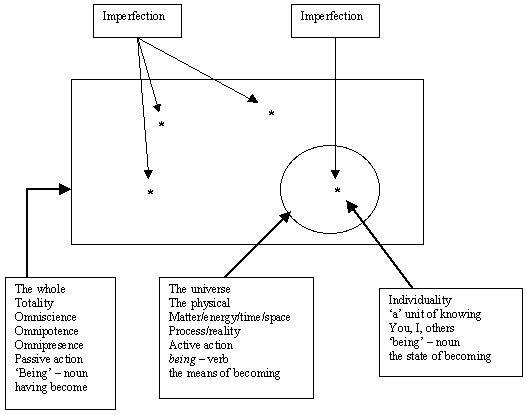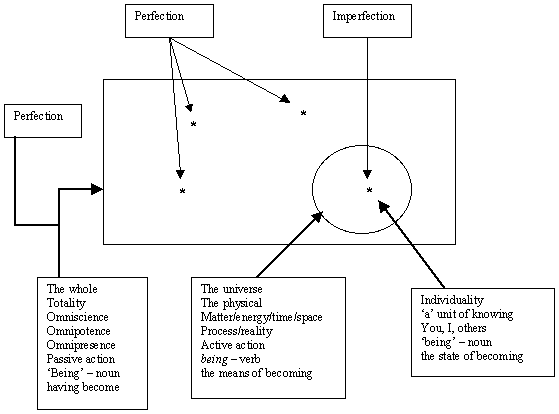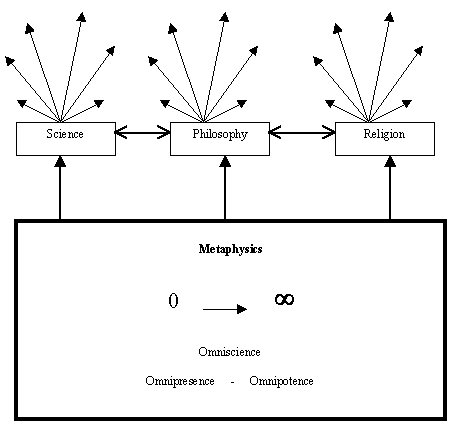|
 
Tractate 5 : The Error of Leibniz (continued)
The location of ‘imperfection’
The question regarding Leibniz then becomes: If imperfection exists, where does imperfection lie within such a system, within a system of ‘being’ being ‘Being’?
Imperfection lies in two locations:

Imperfection lies ‘within’ the sub unit of knowing found inside the whole but outside the location of its development and imperfection lies ‘within’ the sub unit of knowing found inside the whole but inside the location of its development.
Imperfection is found within the sub units because the sub unit is less than the whole and therefore does not rise to the level of the whole because of the very fact that it is not the whole and by the very definition of ‘sub unit’, can never be ‘the’ whole.
The Location of ‘perfection’
The second question regarding Leibniz then becomes: If perfection exists, where does perfection lie within such a system, within a system of ‘being’ being ‘Being’?
Perfection lies in one location:

Perfection lies ‘within’ the whole as the whole. Perfection is the whole for all that is is the whole. The whole is perfectly what it is. The whole is a perfect impression of itself, a perfect resemblance of what is, a perfect appearance of ‘all’. The whole is the only ‘location’ ‘within’ which a perfect semblance of what perfection is
But cannot the same be said of each and every sub unit? Isn’t each sub unit a perfect semblance of itself? Absolutely, but we are discussing the concepts of ‘perfection’ and ‘imperfection’ and by definition:
Perfection: From the Latin perfectio meaning ‘completeness’ or ‘completion’ (William L. Reese, Dictionary of Philosophy and religion, Humanities Press, 1996.)
As such the caption having read ‘imperfection’ in terms of the sub unit of knowing found ‘within’ the whole but ‘outside’ the location of development of the sub unit of knowing has been relabeled ‘perfection’ for such a sub unit is both perfect and imperfect simultaneously.
It is only the whole, which strictly retains the label perfection, and it is only the sub unit found located ‘within’ the whole and ‘within’ the location of development which strictly retains the label ‘imperfection’ for it has not yet attained ‘completion’. It has not yet attained ‘completeness’.
But one may argue that the ‘whole’ appears to ‘change’ within the metaphysical system of ‘being’ being ‘Being’ and thus it would appear the whole should strictly retain the label of ‘imperfection’ for it appears to be an active dynamic system and thus is never reaching ‘completeness’. The issue regarding the whole changing while simultaneously not changing is an exhaustive issue which will be addressed in the more appropriate tractate, Tractate 6: Kant and its subsection: ‘How something which is unchangeable can change and remain unchangeable’. But why wait for the tractate regarding Kant? We will wait for Kant because it was Kant who moved the metaphysical perception of a passive static Aristotelian system into being an active dynamic Kantian system.
Conclusion:
Religiously, scientifically, and philosophically the metaphysical perception of ‘being’ being ‘Being’ is best described as symbiotic panentheism. Such a term incorporates three aspects:
Panentheism:
- Religiously: all in God
- Scientifically: all in the whole
- Philosophically: all in Being
Symbiosis:
- Scientifically: The elements of the whole interact with the whole to make the whole what it is in terms of the whole being an active whole
- Religiously: God and humanity interact one with the other
- Philosophically: ‘being’ interacts with ‘Being’
The fusion power of the two terms lies in the power of reason as directed by metaphysics itself. Such an understanding becomes clearer when demonstrated graphically:

The second shell is best described as a metaphysical system, which explains what it is we have observed, believed, and reasoned throughout the ages. Such a shell is based upon the metaphysical concepts describing the ‘overall’ picture of the whole. Be that as it may, we have not yet come to a consensus as to just what it is all of our perceptual tools, reason, observation, and faith have in common. Such a state of confusion does not exist because we ‘cannot’ come to a consensus regarding the existence of a metaphysical system capable of answering the three fundamental questions but rather the lack of a consensus exists because we have not made a concerted coordinated effort to do so.
We have not made a concerted effort to find acceptable answers to each of the three questions that have been haunting us ever since we began asking the questions. We have not composed the answers to these questions because we have not made a concerted effort to find a metaphysical understanding which bridges the gap between the concept of the three omni’s and our three most haunting of questions.
This is not to say there have not been great philosophical, religious, and scientific thinkers who have made a concerted effort of their own to resolve the issues. Tractates 1, 2, 3, 4, and now 5 have examined such great thinkers and offer a resolution to the issues which they have attempted to address but been unsuccessful at resolving.
Tractates 6 – 12 will address the issues other great individual thinkers such as Kant, Russell, Hegel, Einstein, etc. have to offer.
The lack therefore of a concerted effort has not been due to some individuals but rather the lack of a concerted effort has been due to our collective desire to do so.
The means of finding this second shell, which bridges the interrelationship between the three omni’s and the three fundamental questions haunting our specie, is to find ‘a’ metaphysical model which answers the three fundamental questions which face religion, science, and philosophy simultaneously. Pitting the model against our greatest of philosophical paradoxes can test the model of such an understanding. If the model cannot resolve these paradoxes then we are not yet ready to move onto other paradoxes awaiting more advanced metaphysical dilemmas that surely await us.
It appears it may serve us well to begin the process of building this second shell in order to fill in the air pocket between our visualization of the most basic fundamentals of God and the shell composed of the three basic questions religion, science, and philosophy are all attempting to resolve. It appears this second shell, this metaphysical model, may be the means of understanding omniscience, omnipotence, and omnipresence as it applies to ourselves. It appears that the second shell, a comprehensive universal (literally universal) metaphysical system, may in fact be the means through which we are to understanding the answers to the questions: ‘Where are we? What are we? And, Why do we exist?’
What does finding the model of a universal metaphysical system have to do with Leibniz and theodicy? We have looked at a universal metaphysical model which might very well act as a primitive understanding, which might well resolve the paradoxes placed before us by Zeno, Aristotle, Boethius, and Copernicus. We are now about to enter the debate of paradoxes placed before us by Kant, Hegel, Russell, Einstein, Heidegger, Philosophy, and Society. But historically we have come to Leibniz and his concept of theodicy and it is the concept of God ‘allowing’ ‘evil’ things to happen to ‘good’ people, which brings our metaphysical discussion to a complete halt unless we acknowledge that the personality of God is not the issue of metaphysics. The issue of metaphysics is the issue regarding only the neutral characteristics of the whole itself and how it is these neutral characteristics of the whole interact with the neutral characteristics of the sub elements of the whole, interacts with ourselves, that is of concern to the field of metaphysics.
This process appears to be neutral in nature and so it is, but this does not imply ethics cannot emerge from such a discussion for in fact the most fundamental foundation of ethics itself is what it is that emerges out of such a discussion.
Before we can mold the second shell involving the perceptual tools of faith, observation, and reason, the mutual concepts regarding the religious, scientific, and philosophical characteristics of God must all come together simultaneously and fit our model of God. Leibniz concept of theodicy, omnibenevolence, does not fit the requirement and thus must be discarded in order to get back to our discussion oriented towards building a universally acceptable model, a metaphysical system of the whole of Reality.
Perfection, does it exist? The whole is perfect from the point of view of the whole for the whole is purely and simply the whole. The whole is what the whole is. Does the whole have a sense of ‘moral’ obligation? At first glance such a statement would appear to be a metaphysically ludicrous statement but is it? If the whole is composed of knowing subunits and is a ‘living’ thriving entity, then wouldn’t the whole feel a sense of obligation to the subunits to which it owes its very ability to ‘grow’, ‘change’, find variety itself? If such is the case then not only does such a question become ontologically significant but such a question becomes metaphysically significant for no longer are we dealing with simply a ‘static’ whole but we are dealing with an active dynamic whole whose very active dynamic state depends upon subunits of knowing which develop within the whole itself.
Imperfection, does it exist? Imperfection exists from the point of view of the sub elements, which judge the status of the whole from the point of their personal perceptions. Can the subunit ever ‘judge’ the whole as the whole when the subunit is simply a ‘part’ of the whole and cannot see the whole as the whole? Yes but only from the point of view of the limited perception from which the subunit is capable of viewing the whole. As such the subunit develops ‘judgmental’ perceptions of the whole such as ‘good’and ‘evil’. Ontologically such ‘judgmental’ developments are not actions overreaching the bounds of the subunit, however, metaphysically such ‘judgmental’ developments do overreach the bounds of the subunit and as such must be put aside when discussion the base foundation upon which religion, science, and philosophy themselves must be built.
It appears the next step must be a concerted attempt to find Kant’s categorical imperatives and that is exactly what will take place in Tractate 6: Kant.
And what about the concept of theodicy, which Leibniz had coined? Theodicy/omnibenevolence appears to belong to the ontologists as opposed to the metaphysician. It appears to belong in a shell which lies somewhere beyond the second shell.
Had Leibniz not been so infatuated with his own creation, he may have seen that his piece of the puzzle did not belonged in the first shell with omnipresence and omnipotence. Had Leibniz not been so arrogant he himself may have concluded that his creation of theodicy did not belong in either the first or the second shell protecting the core concept of omniscience, did not belong as a characteristic to be found in any metaphysical understanding of God.
It may appear there is much negativism involved with the misstep of Leibniz. Be that as it may, all is not negative when we look to Leibniz and his concept of theodicy for:
We now understand that:
Leibniz is a vital link in moving our perceptual understanding forward regarding the ‘system’ being filled with ‘imperfection’ into that of being ‘the’ system filled with, metaphysically speaking, neither ‘perfection’ or ‘imperfection’. As such, ‘perfection’ and ‘imperfection’, with the help of Leibniz, now no longer exist as elements of a metaphysical system but rather exist as elements of an ontological dialectic which itself lies beyond the boundaries of all three fields of metaphysics: theoretical metaphysics, practical metaphysics, and metaphysical engineering.
|
|
|